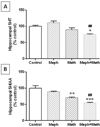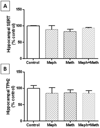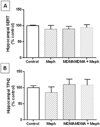Effects of combined treatment with mephedrone and methamphetamine or 3,4-methylenedioxymethamphetamine on serotonin nerve endings of the hippocampus
- PMID: 23892197
- PMCID: PMC3858458
- DOI: 10.1016/j.lfs.2013.07.015
Effects of combined treatment with mephedrone and methamphetamine or 3,4-methylenedioxymethamphetamine on serotonin nerve endings of the hippocampus
Abstract
Aims: Mephedrone is a stimulant drug of abuse with close structural and mechanistic similarities to methamphetamine and 3,4-methylenedioxymethamphetamine (MDMA). Although mephedrone does not damage dopamine nerve endings it increases the neurotoxicity of amphetamine, methamphetamine and MDMA. The effects of mephedrone on serotonin (5HT) nerve endings are not fully understood, with some investigators reporting damage while others conclude it does not. Presently, we investigate if mephedrone given alone or with methamphetamine or MDMA damages 5HT nerve endings of the hippocampus.
Main methods: The status of 5HT nerve endings in the hippocampus of female C57BL mice was assessed through measures of 5HT by HPLC and by immunoblot analysis of serotonin transporter (SERT) and tryptophan hydroxylase 2 (TPH2), selective markers of 5HT nerve endings. Astrocytosis was assessed through measures of glial fibrillary acidic protein (GFAP) (immunoblotting) and microglial activation was determined by histochemical staining with Isolectin B4.
Key findings: Mephedrone alone did not cause persistent reductions in the levels of 5HT, SERT or TPH2. Methamphetamine and MDMA alone caused mild reductions in 5HT but did not change SERT and TPH2 levels. Combined treatment with mephedrone and methamphetamine or MDMA did not change the status of 5HT nerve endings to an extent that was different from either drug alone.
Significance: Mephedrone does not cause toxicity to 5HT nerve endings of the hippocampus. When co-administered with methamphetamine or MDMA, drugs that are often co-abused with mephedrone by humans, toxicity is not increased as is the case for dopamine nerve endings when these drugs are taken together.
Keywords: Bath salts; MDMA; Mephedrone; Methamphetamine; Neurotoxicity; Serotonin.
© 2013.
Conflict of interest statement
All the authors declared no competing interests.
Figures






References
-
- Bowyer JF, Davies DL, Schmued L, Broening HW, Newport GD, Slikker W, Jr, et al. Further studies of the role of hyperthermia in methamphetamine neurotoxicity. J Pharmacol Exp Ther. 1994;268:1571–1580. - PubMed
Publication types
MeSH terms
Substances
Grants and funding
LinkOut - more resources
Full Text Sources
Other Literature Sources
Medical
Miscellaneous

